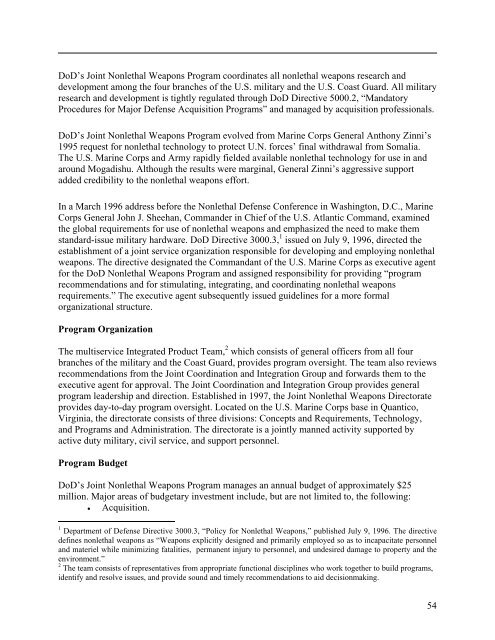Department of Defense Nonlethal Weapons and Equipment Review
Department of Defense Nonlethal Weapons and Equipment Review
Department of Defense Nonlethal Weapons and Equipment Review
You also want an ePaper? Increase the reach of your titles
YUMPU automatically turns print PDFs into web optimized ePapers that Google loves.
DoD’s Joint <strong>Nonlethal</strong> <strong>Weapons</strong> Program coordinates all nonlethal weapons research <strong>and</strong><br />
development among the four branches <strong>of</strong> the U.S. military <strong>and</strong> the U.S. Coast Guard. All military<br />
research <strong>and</strong> development is tightly regulated through DoD Directive 5000.2, “M<strong>and</strong>atory<br />
Procedures for Major <strong>Defense</strong> Acquisition Programs” <strong>and</strong> managed by acquisition pr<strong>of</strong>essionals.<br />
DoD’s Joint <strong>Nonlethal</strong> <strong>Weapons</strong> Program evolved from Marine Corps General Anthony Zinni’s<br />
1995 request for nonlethal technology to protect U.N. forces’ final withdrawal from Somalia.<br />
The U.S. Marine Corps <strong>and</strong> Army rapidly fielded available nonlethal technology for use in <strong>and</strong><br />
around Mogadishu. Although the results were marginal, General Zinni’s aggressive support<br />
added credibility to the nonlethal weapons effort.<br />
In a March 1996 address before the <strong>Nonlethal</strong> <strong>Defense</strong> Conference in Washington, D.C., Marine<br />
Corps General John J. Sheehan, Comm<strong>and</strong>er in Chief <strong>of</strong> the U.S. Atlantic Comm<strong>and</strong>, examined<br />
the global requirements for use <strong>of</strong> nonlethal weapons <strong>and</strong> emphasized the need to make them<br />
st<strong>and</strong>ard-issue military hardware. DoD Directive 3000.3, 1 issued on July 9, 1996, directed the<br />
establishment <strong>of</strong> a joint service organization responsible for developing <strong>and</strong> employing nonlethal<br />
weapons. The directive designated the Comm<strong>and</strong>ant <strong>of</strong> the U.S. Marine Corps as executive agent<br />
for the DoD <strong>Nonlethal</strong> <strong>Weapons</strong> Program <strong>and</strong> assigned responsibility for providing “program<br />
recommendations <strong>and</strong> for stimulating, integrating, <strong>and</strong> coordinating nonlethal weapons<br />
requirements.” The executive agent subsequently issued guidelines for a more formal<br />
organizational structure.<br />
Program Organization<br />
The multiservice Integrated Product Team, 2 which consists <strong>of</strong> general <strong>of</strong>ficers from all four<br />
branches <strong>of</strong> the military <strong>and</strong> the Coast Guard, provides program oversight. The team also reviews<br />
recommendations from the Joint Coordination <strong>and</strong> Integration Group <strong>and</strong> forwards them to the<br />
executive agent for approval. The Joint Coordination <strong>and</strong> Integration Group provides general<br />
program leadership <strong>and</strong> direction. Established in 1997, the Joint <strong>Nonlethal</strong> <strong>Weapons</strong> Directorate<br />
provides day-to-day program oversight. Located on the U.S. Marine Corps base in Quantico,<br />
Virginia, the directorate consists <strong>of</strong> three divisions: Concepts <strong>and</strong> Requirements, Technology,<br />
<strong>and</strong> Programs <strong>and</strong> Administration. The directorate is a jointly manned activity supported by<br />
active duty military, civil service, <strong>and</strong> support personnel.<br />
Program Budget<br />
DoD’s Joint <strong>Nonlethal</strong> <strong>Weapons</strong> Program manages an annual budget <strong>of</strong> approximately $25<br />
million. Major areas <strong>of</strong> budgetary investment include, but are not limited to, the following:<br />
• Acquisition.<br />
1 <strong>Department</strong> <strong>of</strong> <strong>Defense</strong> Directive 3000.3, “Policy for <strong>Nonlethal</strong> <strong>Weapons</strong>,” published July 9, 1996. The directive<br />
defines nonlethal weapons as “<strong>Weapons</strong> explicitly designed <strong>and</strong> primarily employed so as to incapacitate personnel<br />
<strong>and</strong> materiel while minimizing fatalities, permanent injury to personnel, <strong>and</strong> undesired damage to property <strong>and</strong> the<br />
environment.”<br />
2 The team consists <strong>of</strong> representatives from appropriate functional disciplines who work together to build programs,<br />
identify <strong>and</strong> resolve issues, <strong>and</strong> provide sound <strong>and</strong> timely recommendations to aid decisionmaking.<br />
54

















